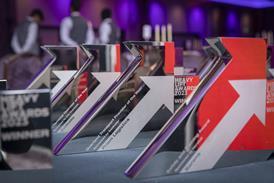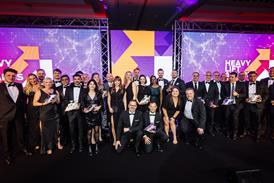Lifetime Achievement Award winner at the Heavy Lift Awards 2019, Steve Drugan, senior vice president at deugro (USA), discusses his distinguished career with David Kershaw.

How and why did you initially get into the logistics industry?
You could say that I got into the transportation and logistics field by accident, because I was looking for a career change from selling insurance. In early 1975, I was hired by Sea-Land Service to sell containerisation to industry in the Northeastern USA.
In 1978, I relocated to Houston with Sea-Land and, in 1981, I crossed over to the international freight forwarding arena, where there was more room for innovation and creativity, and more opportunities to advance.
In 1981 I joined Panalpina, Houston, where I was responsible for sales and business development in the Houston and southwest Texas region. This is when I was first exposed to the breakbulk and heavy lift industry.
During the oil boom in Texas (1978-1983), there were a huge number of drilling rigs under construction both in the USA and in overseas shipyards, and Panalpina enjoyed a healthy slice of that market. Between 1986 and 1996, I focused mainly on the oil and gas upstream business. I also became involved with the management and execution of several turnkey industrial projects.
What were your first impressions of industrial projects and heavy lift logistics?
My initial impression was that these are the most complex, challenging, risk-laden and rewarding segments of the industry. After the first few projects, I was hooked. I knew this was where I wanted to devote my time and energy.
In 1996, I was afforded the opportunity to take over the project division of Panalpina, Houston, and eventually for Panalpina USA. This was a game-changer for me.
Along with the title of vice president projects USA, and bottom line responsibility for the project division, I was allowed to recruit and build my own team of professional project logisticians. All these experiences I brought in as I joined deugro (USA) in 2010. The rest is history!
What has kept you in the industry for 40 years?
First, I am a very competitive person, and this industry provides the ultimate competitive landscape.
Unlike the Olympics, there is no medal for second or third place: it is ‘winner takes all’. Winning new projects and, essentially, reinventing your customer and business base every two to three years, is necessary in order to retain staff and grow the business.
Plus, the project market is dynamic and ever changing. The project forwarder must constantly adapt its services to meet changing needs and to take advantage of potential opportunities. Those companies that figure out the market first and invest in tailored services will have the best chance of financial success.
Another reason for my longstanding in the industry is the personal relationships I have forged. The project owners and EPC clients, my colleagues from the companies where I have worked, the carriers, cargo handlers and sub-contractors are all a big part of the reason I am still in the game.
Last but not least, good health and support from our families comes into play. It would be difficult to be successful without them, due to the stress, sleepless nights, nights out with colleagues and entertaining clients, and the millions of miles travelling to foreign countries. I have been blessed with an understanding wife and two terrific sons.

What are the major changes you have seen in that time?
The mega projects of today are a lot more complex and challenging than those in previous decades.
Large-scale projects typically used to be in the USD100-250 million range and were contracted with the EPCs on a cost reimbursable basis and constructed according to a stick-build concept.
Many of today’s multi-billion-dollar mega projects are contracted on a lump sum basis to multiple EPC contractors, partnered in a joint venture for an individual project, to combine resources and distribute the huge financial risk. Depending on the number of fabrication yards involved with building modules, there may be two or three projects within the same mega project.
Another significant change is that for most of the last 40 years the project market has been mainly in the Middle East, China, Russia, the CIS countries, Southeast Asia, India, South America, Australia, and northern and western Africa. But today we have a massive project market at home in the USA – for instance, in Texas, Louisiana, Pennsylvania and Ohio – due largely to the trend to change refinery feedstock from crude oil to natural gas. Many newbuild refineries and plant expansions are scheduled for construction over the next five to seven years in the USA.
Over time, technology has advanced; international oil companies (IOC), EPCs and project forwarders are utilising sophisticated tools, software programs and analytics to improve visibility, transparency and predictability of outcomes, and to exercise control over the flow of purchase orders and shipments throughout the procurement and transportation processes.
In addition, there is much more emphasis today on Health Safety Security Environment & Quality (HSSEQ) compliance, risk management, sub- contractor management, journey management, commercial strategy and transport engineering. We have come a long way, although there is still ample room for improvement.
Do you have some particularly memorable projects – especially any that were particularly difficult or that went wrong and had to be ‘rescued’?
The projects that are most memorable for me are the ones in Iraq after the Iraqi Freedom War: a series of projects to reconstruct infrastructure after the invasion in 2003.
These were dangerous times – insurgents ambushed our convoys, and trucks and drivers were taken hostage by quasi Customs/police checkpoints inside Iraq. We were able to negotiate their release and managed to deliver power generation and water treatment equipment to multiple jobsites throughout Iraq, with minimal casualties or loss of cargo.
We posted employees in Baghdad, Kirkuk and Port of Umm Qasr during this time to manage our operations in the country. I have great admiration and respect for the devotion and courage of these individuals.
There are always unforeseen problems and challenges while executing projects. The earlier the project forwarder is engaged in the project, the better we can research and flush out the potential risks.
If problems are detected during the course of the project, it is imperative that the forwarder report these to the client immediately – and, if possible, present a proposed solution. Problems that are not reported at the outset tend to grow worse over time. Do not let little alligators develop into big alligators.
Would you encourage a young person to enter the project forwarding and heavy lift industry today?
Yes, definitely. This is a very dynamic and fascinating industry to build a career around. I would recommend that they do their research and due diligence to ensure that the companies they approach for a job have a good reputation and track record of excellence in execution, along with a structured training programme for new hires and interns, and for promoting from within.
What advice would you give to anyone thinking of joining the sector?
Put on your seat belt and get ready for a lifetime of opportunities and challenges. Work hard; work smart; be prepared; listen to your customers; study the market; keep up with technology, training and innovation; communicate with your clients, management and colleagues; build relationships; do not be afraid to fail; take calculated risks; have a career path in mind and share it with your management; and discuss the steps and timeframe needed to reach your goals.
What will you miss most about the job?
Team building and the pursuit of the next mega project, and the adrenaline rush from winning. Next, I will miss the personal relationships with the clients, my colleagues at deugro, and my friends and colleagues in the industry.
What are your plans for the future?
I am planning to retire at some point in the foreseeable future. If I become restless in retirement, I may pursue a part-time position as a consultant.
This article has been taken from HLPFI's November/December edition.
















